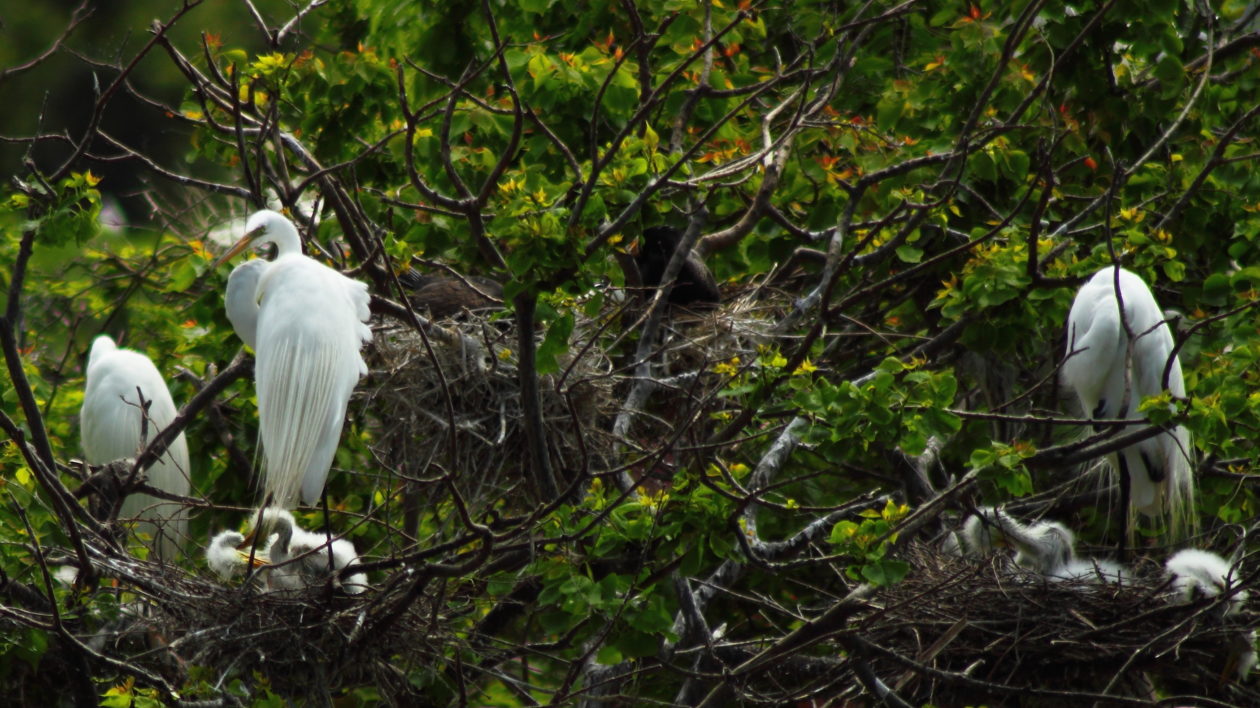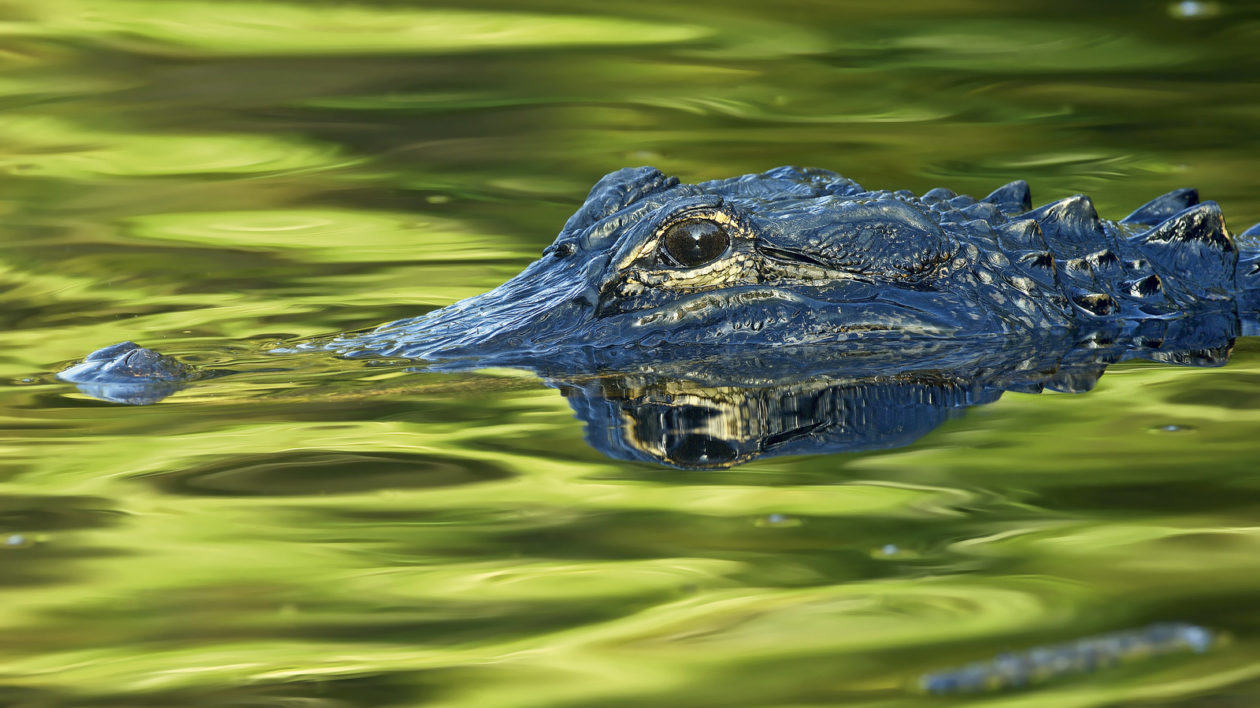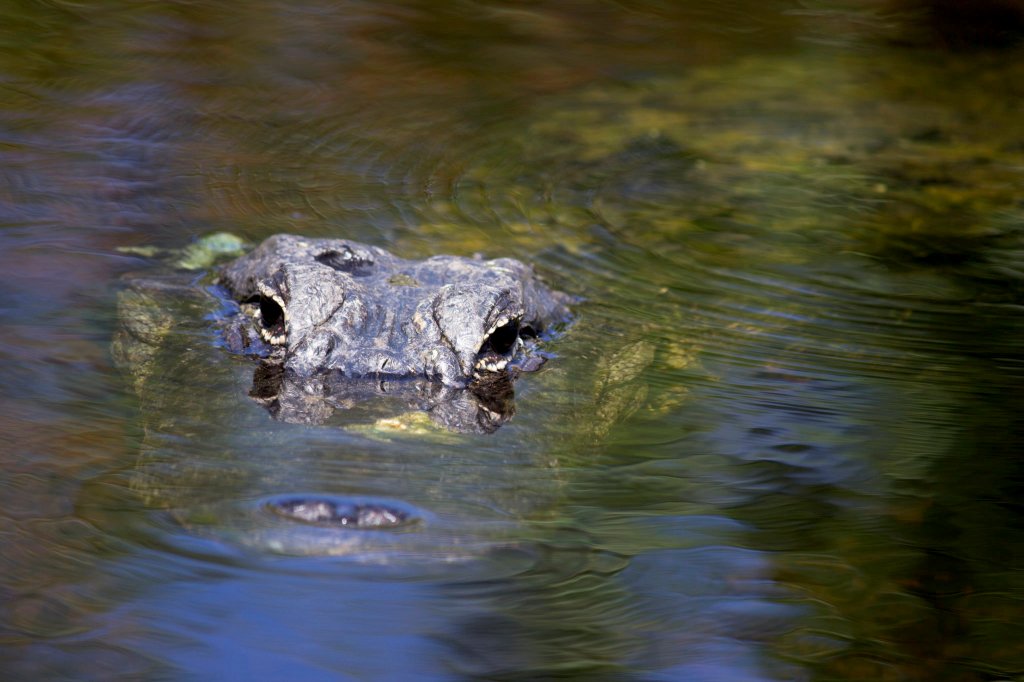Even the most dedicated reptile-lover wouldn’t want an alligator hanging around the school playground.
But for waterbirds in the Florida Everglades, having an alligator near their nesting colonies keeps out other unwelcome visitors. And the arrangement is good for the gators, too. Scientists have discovered that alligators living near nesting bird colonies are healthier than those without access to this food resource, according to new research published today in PLOS One.
Gators & Birds: Not Such an Odd Couple
It’s a scene familiar to anyone who has puttered around South Florida waterways by kayak, canoe, or powerboat. Sawgrass stretches across the wide horizon, while alligators lounge beneath cypress and willow trees festooned with perching egrets, ibis, heron, and anhinga.
“Crocodilians are often found underneath these nesting birds, and this has been a common natural history observation for quite some time,” says Lucas Nell, who conducted this research as part of a master’s in wildlife ecology at The University of Florida.
But what may not be obvious at first glance is that this idyllic tableau is anything but coincidental — alligators and wading birds benefit and depend upon one another.
Previous research by Brittany Burtner found that wading birds do indeed prefer to nest on tree islands adjacent to alligators — something she discovered by putting out fake, plastic alligators and birds throughout the Everglades. Logic follows that there had to be some benefit to nesting near such an obvious predator, and the suspicion is that the alligators were keeping out even more unwelcome neighbors — raccoons and Virginia opossums.
“If raccoons get into a nesting colony it’s just devastating,” says Nell. He explains that thousands of birds will abandon their nests if a raccoon infiltrates the colony because the birds have no real defense against them. “A great egret will peck away at a raccoon and the raccoon will just kind of ignore it and eat the chicks,” he says, leaving nothing but the litter of little bird legs behind.
Burtner found that tree islands surrounded by high water, and therefore gators, have fewer numbers of raccoons or possums, likely because the alligators dissuade — or eat — the mammalian predators. That’s good news for the birds, but what benefit do the gators get from this relationship?

Making Housecalls in the Glades
Nell set out to quantify exactly how beneficial it is to an alligator to have a territory with a breeding bird colony. Focusing on two sites in the Everglades, Loxahatchee National Wildlife Refuge and Water Conservation Area 3A, he used a combination of Google Earth and airboat survey data to identify tree islands with and without colonies of breeding birds.
Then he and his research partners hit the field to capture gators. “You go out at night and you shine your spotlight across the water and you look for their little eyes,” says Nell. “Then you sidle up next them in the airboat… and slip a noose over their neck and cinch it down.” Next, they use a combination of a second noose and tape to secure the gator’s mouth before hauling them aboard the airboat.
In June of 2013 and 2014, they captured 39 female alligators. (Because female alligators have small smaller home ranges than males, their health and body condition would be more reflective of prey opportunities from the bird colonies).
Once the gator was on board, Nell and his team took blood samples and measurements to calculate a morphometric index, which Nell likens to an alligator Body Mass Index, or BMI. A factor of the animal’s weight and snout-to-vent measurement, this index is a good measure of the gator’s health.
Nell’s results revealed that alligators with nesting colonies in their territories measured 13 percent higher on that index compared to alligators with no nesting colonies nearby. “For about a 6-foot gator, they will on average weigh about 6 pounds more if they’re near a colony,” he says.
They didn’t find any major differences in the alligators’ bloodwork, but Nell says that’s not entirely surprising, because even non-colony-adjacent alligators did have access to food resources and weren’t starving.

An Uneasy Alliance
However much alligators and nesting bird colonies benefit from one another, Nell cautions that it’s not an idyllic relationship. “Nesting above an alligator is less like having a bodyguard and more like having a psychopath in your yard to keep out catburglars,” he says.
Nell says that there are reports of alligators slapping against tree trunks to knock wobbly-legged chicks into the water below, and his colleague once observed a small gator actually scampering up the side of a tree to snatch an ibis chick out of a low-lying nest.
Nesting above an alligator is less like having a bodyguard, and more like having a psychopath in your yard to keep out catburglars.
Lucas Nell
Alligators benefit wading birds in other ways, besides this perverse protector-turned-predator relationship.
“Alligators act as both apex predators and ecosystem engineers,” says Nell. As they wallow and wade through the waterways of the Everglades, alligators create holes and small ponds that retain water even in the drier months and years when water levels drop precipitously. “Those ponds create refuges for fish and aquatic invertebrates when it’s extremely dry,” says Nell, “and sometimes those are the only organisms of those types to survive in extremely dry years because that’s the only water around.”
Nell hopes that this research will encourage other ecologists to tease apart similar mutualistic relationships elsewhere in the tropics and subtropics, where other species of wading birds and crocodilians live in close proximity.
It may be an uneasy alliance, but it works: Alligators get the occasional airborne snack, and birds get protection from predators. That is, as long as they stay out of jaws-reach.




So why in our area and presumably others do snowy egrets and other birds congregate around an alligator sunning on the bank?!
We have a number of gators in our golf community; they sun on pond banks, surrounded by birds. These birds have the entire pond to “hang out on”, but they choose to surround the alligator, often within one foot of the toothy grin.
I was in Everglades National Park just a few weeks ago. In both the east and west sections the rangers were talking about the sad state of the Everglades mainly because of the Burmese Pythons. They said there are practically no mammals left. No mammals have been seen for months. Raccoons are not the problem anymore. The pythons have eaten all the mammals from large to small. Deer, rabbits, raccoons, opossums, mice have all disappeared. Because the alligators are not getting red meat anymore their color is even changing. They are left with a mainly fish diet. There needs to be so much more attention paid to this problem if the necessary balance in the Everglades is ever to come close to what it should be. No one can figure out how to hunt the pythons. Their population is huge, way more than 10,000. There is no good way to count them. Why is this not being brought to the attention of the public? They should have a state or nation-wide contest for solutions on how to find them and hunt them without hurting the environment. Shooting them barely changes their rapidly growing population. In addition, the pythons are moving out of the Everglades to more populated parts of south Florida.
” A Great Egret will pick away at a raccoon and the raccoon will just kind of ignore it and eat the chicks ” he says, leaving nothing but the litter of little bird legs behind.
Was it really necessary to include the part about “leaving nothing but a litter of little bird legs behind”? Given that you have not placed quotation marks around that part of the sentence, it would seem that you are not quoting Lucas Nell.
It’s hard enough to read about chicks being eaten alive. I really don’t need such a graphic description and would imagine that plenty of other readers could have done without it. I feel ill now.
Thanks for the beautiful articles, pictures & nature guide book reviews. Is there a guide for locusts? I’m especially interested in Schistocerca gregaria.
History of swarms, crop damage, how climate effects reproduction, and the possibility that this locust may be referred to in Exodus & Joel. I’m interested in the similarities of locust & grasshoppers. Damage they do is the same. I’ve studied this a little already.
Thanks for the kind words, Daniel. As far as locusts: The Field Guide to Grasshoppers, Katydids and Crickets of the United States referenced in my field guide blog (https://blog.nature.org/2015/01/21/best-fieild-guides-birding-naturalist-wildlife-insects-fish-parks/) would cover locusts in the US. Locusts are the migratory form of grasshoppers, fascinating biology in its own right.
While not a field guide, the book Locust by Jeffrey Lockwood is an absolutely fascinating read and would likely be of great interest to you. It is about the human-locust relationship through time, including a time when locusts were put on trial to decide whether they originated from Heaven or Hell (true story), the plight US farmers faced with locust swarms and the mysterious disappearance of those swarms. It is first-rate science writing, one of my favorite books. Enjoy!